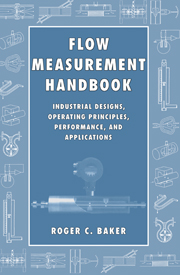Book contents
- Front Matter
- Contents
- Preface
- Acknowledgments
- Nomenclature
- Chapter 1 Introduction
- Chapter 2 Fluid Mechanics Essentials
- Chapter 3 Specification, Selection, and Audit
- Chapter 4 Calibration
- Chapter 5 Orifice Plate Meters
- Chapter 6 Venturi Meter and Standard Nozzles
- Chapter 7 Critical Flow Venturi Nozzle
- Chapter 8 Other Momentum-Sensing Meters
- Chapter 9 Positive Displacement Flowmeters
- Chapter 10 Turbine and Related Flowmeters
- Chapter 11 Vortex-Shedding, Swirl, and Fluidic Flowmeters
- Chapter 12 Electromagnetic Flowmeters
- Chapter 13 Ultrasonic Flowmeters
- Chapter 14 Mass Flow Measurement Using Multiple Sensors for Single- and Multiphase Flows
- Chapter 15 Thermal Flowmeters
- Chapter 16 Angular Momentum Devices
- Chapter 17 Coriolis Flowmeters
- Chapter 18 Probes for Local Velocity Measurement in Liquids and Gases
- Chapter 19 Modern Control Systems
- Chapter 20 Some Reflections on Flowmeter Manufacture, Production, and Markets
- Chapter 21 Future Developments
- Bibliography
- A Selection of International Standards
- Conferences
- References
- Index
Chapter 13 - Ultrasonic Flowmeters
Published online by Cambridge University Press: 22 September 2009
- Front Matter
- Contents
- Preface
- Acknowledgments
- Nomenclature
- Chapter 1 Introduction
- Chapter 2 Fluid Mechanics Essentials
- Chapter 3 Specification, Selection, and Audit
- Chapter 4 Calibration
- Chapter 5 Orifice Plate Meters
- Chapter 6 Venturi Meter and Standard Nozzles
- Chapter 7 Critical Flow Venturi Nozzle
- Chapter 8 Other Momentum-Sensing Meters
- Chapter 9 Positive Displacement Flowmeters
- Chapter 10 Turbine and Related Flowmeters
- Chapter 11 Vortex-Shedding, Swirl, and Fluidic Flowmeters
- Chapter 12 Electromagnetic Flowmeters
- Chapter 13 Ultrasonic Flowmeters
- Chapter 14 Mass Flow Measurement Using Multiple Sensors for Single- and Multiphase Flows
- Chapter 15 Thermal Flowmeters
- Chapter 16 Angular Momentum Devices
- Chapter 17 Coriolis Flowmeters
- Chapter 18 Probes for Local Velocity Measurement in Liquids and Gases
- Chapter 19 Modern Control Systems
- Chapter 20 Some Reflections on Flowmeter Manufacture, Production, and Markets
- Chapter 21 Future Developments
- Bibliography
- A Selection of International Standards
- Conferences
- References
- Index
Summary
INTRODUCTION
The first proposal for the use of ultrasound for flow measurement, according to Thompson (1978), seems to have been in a German patent of 1928. It was not until after 1945 that the idea became more widely proposed. But not until the development of piezoelectric transducers in the past 40 years or so have ultrasonic applications become really attractive. Fischbacker (1959) provided an early review of ultrasonic flowmeters in which, essentially, the transit-time, sing-around, and beam deflection methods were mentioned. He also referred to phase-difference measurement, means of obtaining sound speed from time measurement and impedance, and how to obtain density. He saw the advantages of off-axis paths.
Sanderson and Hemp's (1981) review is still a useful source of information on the subject. The ultrasonic flowmeter's attraction as a flow measurement device is its linearity, lack of obstruction to flow, and, in contrast to the magnetic flowmeter, its ability to measure the flow of gases.
In this chapter, we shall consider three main types of ultrasonic flowmeter, and it is important to understand the strengths and weaknesses of each and that they are very different in performance and application.
The transit-time flowmeter, or time-of-flight flowmeter, is the most accurate of the family and is available as a spool piece meter for liquids and gases or as a clamp-on design for liquids only. It can also be retrofitted into a pipe. Measurement uncertainty will be from a fraction of a percent to about 5%.
Information
- Type
- Chapter
- Information
- Flow Measurement HandbookIndustrial Designs, Operating Principles, Performance, and Applications, pp. 312 - 356Publisher: Cambridge University PressPrint publication year: 2000
Accessibility standard: Unknown
Why this information is here
This section outlines the accessibility features of this content - including support for screen readers, full keyboard navigation and high-contrast display options. This may not be relevant for you.Accessibility Information
- 3
- Cited by
